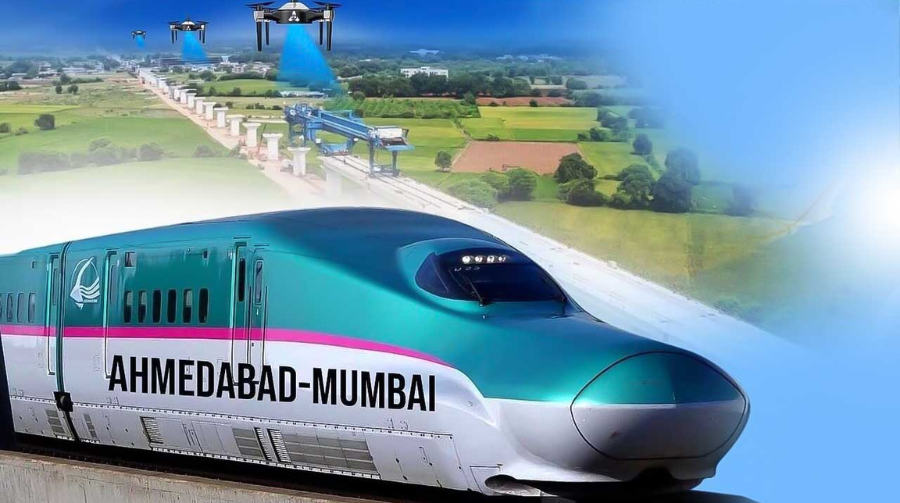News
Mumbai-Ahmedabad Bullet Train India Completes 21 km Undersea Tunnel A Historic Engineering Feat
The Vision Behind the Bullet Train Project
The Mumbai-Ahmedabad bullet train is India’s first high-speed rail corridor, developed with assistance from Japan. The project aims to:
- Reduce travel time between Mumbai and Ahmedabad from 6-7 hours to about 2 hours.
- Promote faster, cleaner, and safer transportation.
- Boost economic connectivity between Maharashtra and Gujarat.
With a design speed of 320 km/h, this train symbolizes the future of travel in India.

The Need for an Undersea Tunnel
One of the most fascinating components of this project is the undersea tunnel near Thane creek, stretching for 21 km, including about 7 km directly below the sea.
This tunnel was essential because:
- It allows the train to bypass dense urban areas and minimize land acquisition challenges.
- It preserves environmentally sensitive coastal regions.
- It demonstrates advanced engineering capabilities similar to those seen in Japan’s Shinkansen system.
How the 21 km Undersea Tunnel Was Built
The tunnel was constructed using advanced Tunnel Boring Machines (TBMs) and New Austrian Tunneling Method (NATM) techniques.
Key highlights:
- Diameter of about 13.2 meters, enough to accommodate the double-track bullet train.
- Advanced waterproofing and pressure-resistant structures to withstand sea forces.
- Special marine-grade concrete used to ensure durability and safety.
Engineers worked in shifts 24×7 to ensure timely progress, while underwater excavation involved robotic mapping, precise blasting, and real-time monitoring.
Engineering Challenges and Innovative Solutions
Building an undersea tunnel is no easy feat. Major challenges included:
- High water pressure and risk of leakage.
- Soil stability under the seabed.
- Ensuring worker safety in low-oxygen and high-humidity environments.
- Coordination with marine traffic and ecological regulations.
Innovative solutions included:
- Using multiple TBMs simultaneously to speed up boring.
- Installing pre-cast tunnel linings for immediate reinforcement.
- Developing a state-of-the-art ventilation and drainage system inside the tunnel.
Expected Impact on Travel and Economy
Once operational, the Mumbai-Ahmedabad bullet train is expected to:
- Cut travel time dramatically to about 2 hours.
- Enhance business travel and trade between Maharashtra and Gujarat.
- Increase tourism in both states.
- Generate thousands of jobs, from construction workers to service staff.
The high-speed corridor will also serve as a model for future bullet train routes in India, such as Delhi-Varanasi and Mumbai-Nagpur.
Environmental Considerations and Safety
Despite the scale, environmental protection was a major focus:
- Real-time monitoring of marine life during construction to avoid ecological harm.
- Noise and vibration control to protect aquatic and coastal species.
- Tunnel design to withstand seismic activity, a critical factor in the western coastal belt.
Safety measures include advanced fire detection, emergency exits every 500 meters, and high-tech air filtration systems.
The Future of High-Speed Rail in India
The success of this tunnel and overall bullet train project paves the way for:
- Faster approvals and execution of upcoming corridors.
- Adoption of more indigenous technology with Japanese collaboration.
- Potential for hyperloop or maglev trains in the future.
The government aims to transform the country’s rail network into a modern, efficient, and green system.
Global Reactions and Strategic Importance
Countries like Japan, France, and Germany have praised India’s engineering achievement.
The tunnel strengthens India’s strategic image, showcasing its ability to deliver large-scale infrastructure projects that match global standards.
Moreover, it highlights India’s commitment to climate-friendly, fast, and reliable transportation systems.
Conclusion
The 21 km undersea tunnel of the Mumbai-Ahmedabad bullet train is not just a tunnel — it’s a passage to a new era of connectivity, innovation, and national pride.
As India prepares for its first bullet train service, this engineering triumph sends a strong message: India is ready to race ahead, both under the sea and into the future.